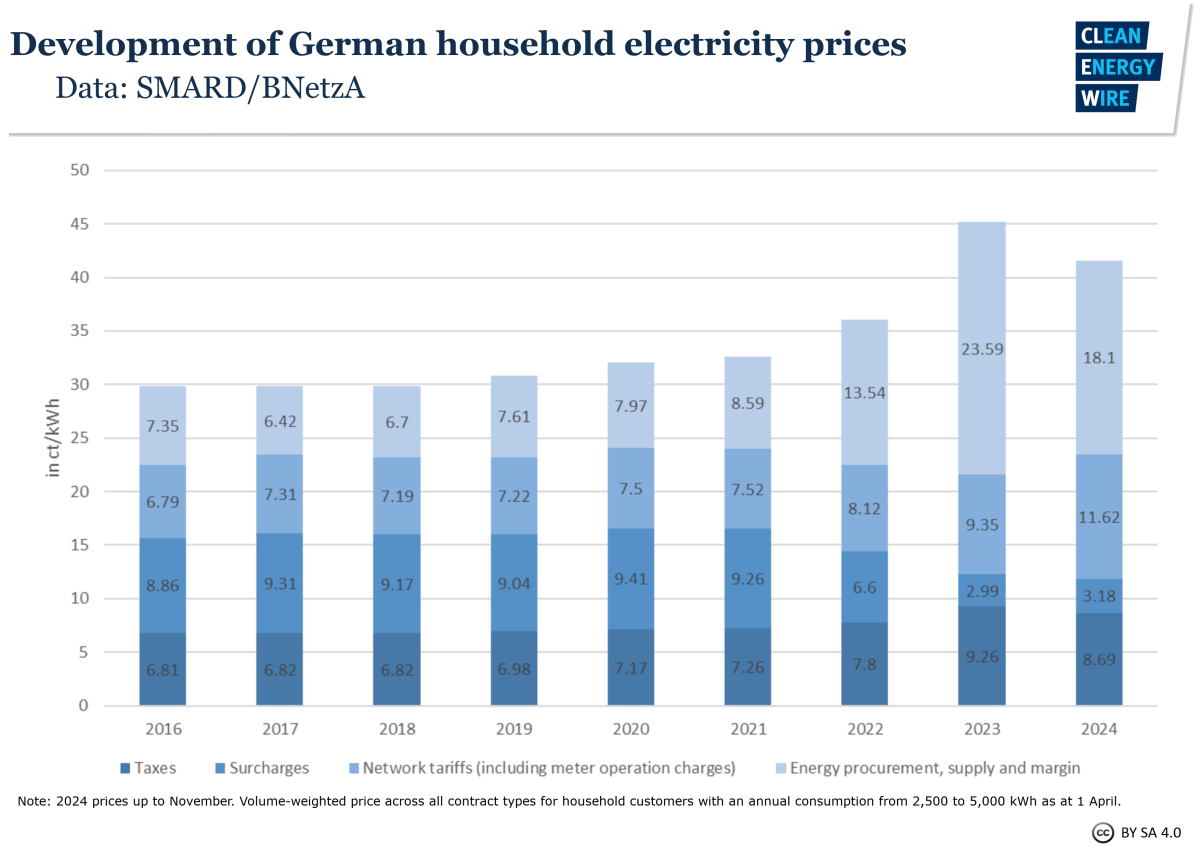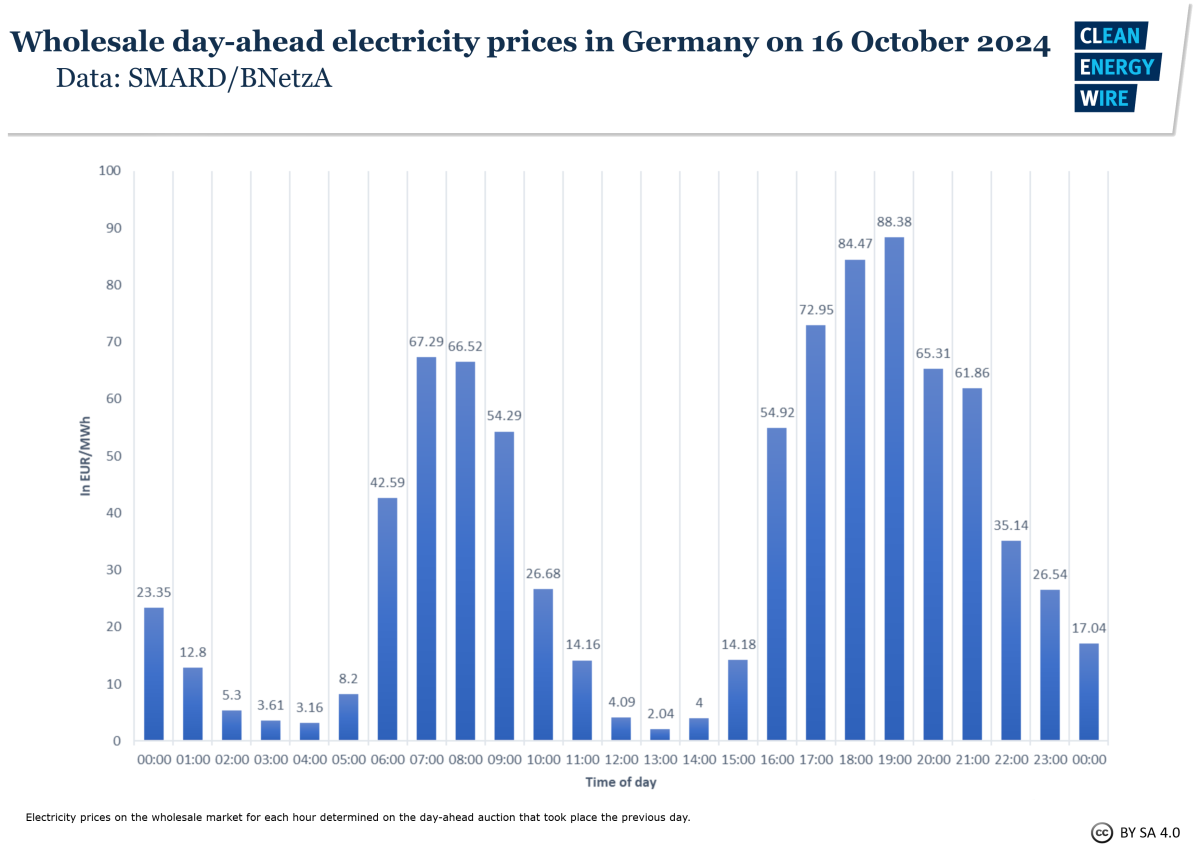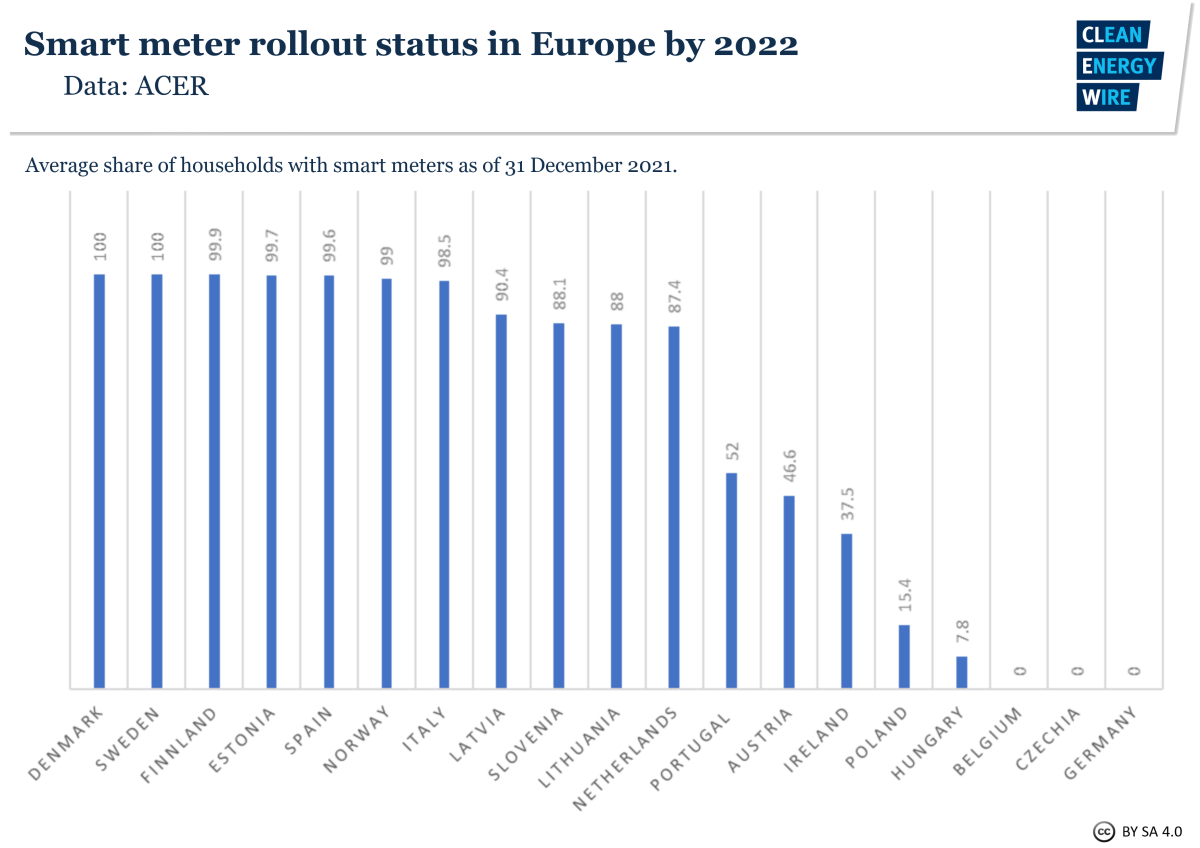Q&A: What are dynamic electricity tariffs and why are they central to the energy transition?
Contents
- What are dynamic electricity tariffs?
- How do dynamic electricity tariffs work?
- Why are dynamic electricity tariffs important for the energy transition?
- How else can households be financially incentivised to adapt their electricity consumption?
- Who benefits the most from dynamic electricity pricing?
- Where is Germany in the implementation of dynamic electricity tariffs?
- What is the experience using them across Europe?
***Please note: This factsheet is part of a series on how electricity markets are evolving to support the energy transition. Find the full deep dive here.***
What are dynamic electricity tariffs?
Dynamic electricity tariffs are a type of electricity contract with a constantly changing price for electricity. Instead of paying a fixed price throughout the year, households pay a different rate, which typically varies by the hour, for every kilowatt hour (kWh) used. The idea is to encourage households – who can see a day in advance what the hourly rates will be – to consume electricity when it is plentiful and prices therefore lower.
The power prices are based on the day-ahead wholesale electricity market (a pan-European market where electricity is traded based on expected supply and demand, more below), as well as local grid fees and other taxes. The rate per kWh tends to be cheaper on average for dynamic tariffs compared to electricity contracts with a fixed price.
In the first half of 2024, households with a dynamic electricity contract which adapted their consumption to the hours when it was cheapest saved up to 34 percent of electricity costs, compared to the average power price on the wholesale market (excluding fees and taxes), according to smart home company tado°.

How do dynamic electricity tariffs work?
Dynamic electricity tariffs give households and small businesses some access to power prices on the wholesale electricity market, where large companies buy and sell electricity – for example, in order to deliver it to households.
Industry electricity prices in Germany
Many energy-intensive industries in Germany already source their electricity at wholesale prices by buying it on the exchange, meaning they effectively have dynamic electricity contracts. They can also buy electricity directly from utilities or operate their own plants. Many have made their electricity consumption more flexible to benefit from the price swings that have accompanied the rollout of intermittent renewable power.
Households and small and medium-sized businesses (SMEs), on the other hand, usually have standard electricity contracts with a fixed rate.
The price of electricity in the wholesale market fluctuates throughout the day, depending on factors such as wind and sunshine, and the demand for electricity. The price is determined by the so-called merit order, meaning the power plant with the highest running costs that is needed to meet total electricity demand at a particular time – in addition to all the cheaper plants already running – determines the price for all buyers. Because renewables have extremely low running costs, they push more expensive generation technologies out of the market when the sun is shining or the wind is blowing, lowering the price for all wholesale buyers. As a rule of thumb, this also means that the cheapest electricity is also the cleanest, because it has a high renewable share.
In summer months or during sunny weekends when electricity demand is low, for example, wholesale electricity prices tend to drop significantly around midday as millions of solar panels feed electricity into the grid.

However, these price fluctuations are not usually passed on to consumers with fixed tariffs, such as households. This is partly for technical reasons: Conventional power meters only record total power consumption, without registering the timing. But so-called “smart meters” allow electricity providers to determine how much electricity a household consumes at any given time, and bill them accordingly if they have a dynamic tariff. Therefore, these more sophisticated metering systems are a precondition for dynamic electricity tariffs.
Volatile pricing does not exclusively mean households benefit from low prices – they are also exposed to the risk of running into high price peaks. Still, some dynamic electricity contracts include a price cap.
What are smart meters?
Smart meters are a requirement for dynamic electricity tariffs. These are devices that can record how much and when electricity is used and transmit this real-time data to the electricity provider and grid operator.
Conventional electricity meters only measure total electricity consumption, and are typically checked once a year to establish whether actual electricity use matches the household's contract.
Almost every household in Denmark, Estonia, Finland, Italy, Spain and Sweden is equipped with a smart meter, according to a 2023 report by the European Commission. In contrast, Germany, Hungary, Czechia and Belgium lag way behind in rolling them out.
Why are dynamic electricity tariffs important for the energy transition?
Renewables are the cheapest form of generating electricity today, and the fastest growing power source in both Germany and Europe as a whole. However, as their share in the power mix rises, conventional energy systems need to adapt.
Due to the rapid expansion of solar power installations, for example, Germany's energy industry has warned of the risk of power cuts if feed-in cannot be controlled in future, as grids could soon be overburdened.
"We are going to have a huge problem with the energy transition if we continue with business as usual," Jannik Schall, co-founder of smart home energy management start-up 1KOMMA5°, told Clean Energy Wire.
Most electricity systems across the globe are still largely guided by demand, with generation adapting accordingly. This worked well when controllable coal and gas power plants formed the backbone of the power mix. However, the aim is for renewables – which are cleaner and cheaper, but intermittent by nature – to dominate the power market. To achieve this, the power system requires much more flexibility, because demand will need to adapt to generation to a much larger extent.
As such, dynamic electricity tariffs are a tool for ensuring that electricity supply and demand are better harmonised.
Using existing infrastructure to make electricity demand more flexible could significantly cut the costs associated with transitioning to a climate neutral power system. "The easiest and most affordable way to make the most of renewables is to ensure demand follows supply and not the other way around," Schall said. "This is a fundamental change, and dynamic electricity contracts are part of this."
By adapting when they use electricity to times of high supply – or, conversely, avoiding times of low renewable generation, when prices are high – households can play a key role in helping to avoid grid overloads. Reducing demand at times of low renewable generation also reduces the need for expensive so-called “peaker” power plants that only run once in a while to supplement renewables at times of peak demand. These issues are set to become even more salient in the future, because the increasing electrification of transport (electric cars), heating (heat pumps) and industry (electric heat) will boost total power demand, thus increasing the burden on grids.
A more flexible electricity system can also save on grid expansion and modernisation costs, as load peaks are reduced through better matching of supply and demand. It also makes better use of already existing renewables, as a significant portion of today's renewable power output has to be curtailed because grids cannot cope. Flexibility thus improves the reliability of the power system and allows to meet net zero targets more cost-effectively.
Case study: What is the potential of flexible household electricity consumption in Germany?
In Germany, the smart charging of electric vehicles or smart running of heat pumps could make ten percent of the country’s entire electricity consumption flexible by 2035, according to a report by clean energy think tank Agora Energiewende.
If around half of Germany's households used electricity flexibly for their electric cars, heat pumps and home storage systems, around 4.8 billion euros could be saved in fuel and investment costs by the middle of the next decade, which would otherwise be required for hydrogen power plants and large batteries.
How else can households be financially incentivised to adapt their electricity consumption?
Some utility companies provide time-variable or time-of-use electricity tariffs, which do not require a smart meter but still somewhat incentivise households to adapt their electricity consumption. Similar to happy hour at a bar, these tariffs give customers a different price for electricity depending on the time of the day, with electricity consumed during off-peak hours being cheaper.
These time variable tariffs are essentially the same as standard electricity contracts, with the exception of set times – for example daytime and nighttime, weekdays and weekends, or even different seasons – with cheaper prices. They are not connected to the wholesale electricity market, meaning that what consumers pay within the different time windows remains the same, regardless of the actual wholesale power price. Daytime and nighttime power prices have been commonplace across Europe for many years.
Many companies are also coming up with innovative electricity contracts to make the most of the rise of renewables. The supplier Rabot Charge, for example, offers users an algorithm to smartly (automatically) charge their electric vehicles (EV) when electricity is cheapest and therefore cleanest. Octopus Energy guarantees customers in Germany a maximum electricity price of 20 cents per kilowatt hour when charging their EVs flexibly overnight, while offering five hours of lower prices every night for the entire household. All households with a contract with these suppliers have to do it plug in their EV, with the utility's software systems automatically deciding the "best" time to charge.
Another such company is start-up 1KOMMA5°, a one-stop-shop for homeowners: They sell, install and manage the operation of solar panels, heat pumps, home storage systems and EV charging stations. In a fully automated process, their energy management system runs the home's heat pump when the electricity price is lowest and sells surplus electricity in storage systems back to the market when prices are high, for example.

Who benefits the most from dynamic electricity pricing?
The biggest cost savings are seen by households with relatively large electricity consumption with the ability to shift their demand to times of low prices. These types of tariffs usually make the most sense for households with an electric vehicle, heat pump, as well as solar panels and a home storage system, according to a report commissioned by vzbv, the Federation of Consumer Organisations. This raises social issues, because high-income households can significantly lower their electricity bills, while poorer ones simply lack the expensive climate-friendly technologies required to do so.
A separate report by the European Consumer Organisation (BEUC) found that households with heat pumps in Belgium, Spain and Italy who switch to dynamic price tariffs can save between 460 and 1,350 euros per year, compared to a baseline scenario of a standard power contract and a gas boiler. The benefits of dynamic pricing, however, varied significantly between countries, depending on national electricity taxation levels, the BEUC said.
Still, the widespread adoption of dynamic electricity tariffs would ultimately reduce power costs across the board. "By smartly charging their car or smartly controlling their heat pump, users reduce not only their own costs, but costs for all energy system users, including those without EVs or heat pumps," said Jaap Burger, consultant at the clean energy think tank Regulatory Assistance Project (RAP).
Some companies offer smart energy control software that automatically manages electricity consumption for households with a dynamic electricity tariff. With smart energy management, consumers can make the most of this type of contract, as it allows them to go about their daily lives without thinking about when it might be best to plug in their EVs or operate their heat pumps. Some offers go even further and connect home batteries with the electricity market, selling surplus power when wholesale prices are high and bringing money back into the household.
Where is Germany in the implementation of dynamic electricity tariffs?
Utility companies in Germany will have to offer dynamic electricity tariffs to all consumers from the beginning of 2025, an obligation that already applies to large suppliers with more than 100,000 customers.
However, more than half of German households have not heard of dynamic electricity pricing, with 81 percent of them feeling poorly informed on the topic, according to a survey by consumer group vzbv. A separate survey by solar leasing company Enpal found that just over 75 percent of people in Germany have either never heard of smart meters, or have heard of them but are not entirely sure what they are. Market players do not think the new requirement will lead to the widespread adoption of the tariffs.
Despite multiple attempts by the German government to accelerate the rollout of smart meters, their uptake in the country is among the lowest in the EU. This "has been causing trouble for 17 years now," der Spiegel reported. "Strict IT security requirements and a power struggle between technical and security authorities have slowed down their distribution in Germany."
Germany requires smart meters to be able to both send and receive information, in order to allow grid operators to throttle electricity to households or switch off solar panels to prevent overloads. However, the ability to control power usage remotely significantly increases the security requirements of smart meters, increasing prices and limiting the range of products.
Over 40 percent of households in Germany that already own solar panels with storage, a heat pump or an electric car are willing to switch to a dynamic tariff, according to a survey commissioned by the German Electrical and Digital Industry Association (ZVEI).
What is the experience using them across Europe?
The majority (73%) of households in the EU have regulated fixed-price or market-based fixed-price electricity contracts, according to a 2024 report by ACER, meaning that nearly three quarters have no incentive to consume electricity flexibly.
In many cases, the infrastructure needed is there: in 14 Member States – including Denmark, Spain, Italy, Finland and Sweden – over 80 percent of households have a smart meter. However, lack of information or offers can get in the way. For example, despite the wide availability of smart meters in Ireland, France, Portugal, Malta and Luxemburg, households did not have access to dynamic electricity tariffs in 2023.
"Countries with a high proportion of smart meters, electric vehicles and heat pumps have the most [dynamic] tariffs and services," according to RAP's Burger. "The Scandinavian countries – Norway, Sweden, Finland and Denmark – are leading the way."
A report by consultancy LCP, which examined 600 household electricity tariffs across Europe, concluded that this is, in many cases, primarily thanks to country-specific factors such as high heat pump and EV uptake, lower price volatility through high hydropower reserves, and high trust thanks to supportive government policies.
For example, by January 2024, 77 percent of Swedish households had some form of dynamic electricity contract, according to ACER's 2024 report. Over a three-year period from 2021 to 2023, households with a dynamic hourly contract which adapted their consumption saved around 42 percent on annual electricity costs compared to a one-year fixed-price contract.
This is, in part, made possible by the widespread use of electric heating, which enables households to shift away from peak hours using automation.
While households with one-year fixed contracts (in the country's pricing zone SE4) paid less than those on dynamic contracts in 2021, in 2022 and 2023 dynamic hourly contracts were cheaper, meaning that overall, dynamic contracts proved to be the most cost effective, ACER highlighted.
In Spain, a third of households have a regulated dynamic time-of-use tariff (known as PVPC), where the cost of electricity varies by the hour but also has a guaranteed ceiling, according to transmission system operator Red Eléctrica de España.
Consumers with a PVPC could save eight to eleven percent on their annual bills by adapting electricity consumption, based on 2023 prices, according to ACER's analysis. This depended on whether households were typically equipped or highly electrified. Moreover, these consumers can not only lower individual costs but also contribute to lower overall power system costs by mitigating price peaks and reducing the need for costly grid upgrades.

